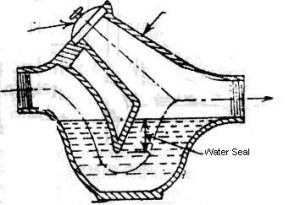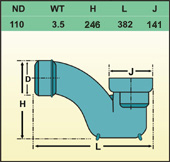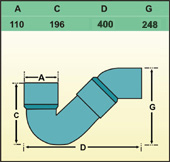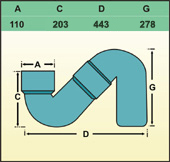

TRAPS
Traps may be defined as fittings placed at the ends of the soil pipes or waste (sullage) pipes to prevent passage of foul gases from the pipes to the outside. The traps maintain water seal which is a standing water between the pipe and the outside to facilitate this. The water seal does not allow gases to escape to the outside of the pipe. The efficiency of a trap will depend on the depth of water seal. Greater the depth of water seal will be more effective. The depth of water seal generally varies from 20 mm to 75 mm.

Traps Cross section
Requirement of a Good Trap:
A good trap should possess the following qualities.
- It should provide sufficient water seal.
- Its interior should be smooth, so as not to obstruct the flow, and thus the trap should be self- cleansing.
- It should be provided with an access door for cleaning.
- It should be made of some non-absorbent material.
Types of Traps:
The three types of traps are P-trap, Q-trap and S-trap as shown in Fig. 8.1. A trap essentially consists of U-tube, which retains water, acting as a seal between the foul gases (inside the pipe) and outside atmosphere. They are largely used for baths, sinks and laboratories. In all such needs, they are made with enlarged mouth, so that the waste pipe may be thoroughly flushed out.
Depending upon their use the traps are classified into following three types.
- Floor traps,
- Gully trap, and
- Intercepting trap.
Floor traps : These traps are generally used to admit sullage from floors of kitchen and bathrooms. These are invariably provided with CI or GI stainless steel gratings at the top so as to prevent the entry of solid matter into drainpipe. Fig. shows the features of floor trap.
Gully traps : A gully trap is often provided at the junction of a room or a roof drain and other drain coming from bath, kitchen etc. The foul sullage from bath will enter through side inlet and the non- foul washings from room or rainwater from roof will enter from top and discharging into drains. Gully trap may either have a S-trap or P-trap. Fig. shows the features of gully trap.
Intercepting traps : An intercepting trap is often provided at the junction of a house sewer and a municipal sewer, so as to prevent entry of foul gases from of the municipal sewer into the house drainage system. It has a high water seal of 100 mm depth. Fig. shows the intercepting trap.

Intercepting traps
3 Responses to “TRAPS”
Leave a Reply










 LIKE TO GET UPDATES
LIKE TO GET UPDATES  TO GET EXPERT GUIDE
TO GET EXPERT GUIDE
thax 4 help
Thank you sir,good article
Thank you for the information.